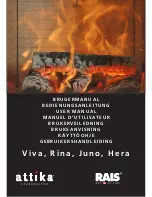
Providing adequate air space around
the stove will allow the stove to
radiate heat and circulate warm air
around the room. It will also prevent
structural damage to the walls and
potentially damaging over-heating of
the stove. If it is not possible to
maintain these spaces they could be
reduced to 100mm (4”) at the sides but
only if this can be compensated with
twice the equivalent air space at the
top of the stove and the non-
combustible wall parts are at least
200mm (8”) thick.
Walls adjacent to free-standing stoves
should be made of non-combustible
material and be a minimum of 200mm
(8”) thick.
Flue Draught
This stove has been
tested with the ideal flue draught of
12 Pa to maximise performance. We
recommended that the chimney system
should reach this
The Chimney, Flue and Flexible
Liners
Other appliances should not
share or be connected to the same flue
system or chimney.
If you are using an existing chimney
and it has been checked for condition
and suitability (see below), in the
interests of safety you must ensure that
it is swept before the stove is installed,
even if it has never been used or you
intend to use a flexible liner. To find a
local registered sweep visit The National
Association of Chimney Sweeps at
www.chimneyworks.co.uk
or the
Guild of Master Chimney Sweeps at
www.guildofmasterchimneysweeps.
co.uk
.
25
The recommended minimum height for
the chimney / flue system from the top
of the stove to the top of the chimney
terminal is 4.5m (15’). If this is not
possible then a ‘spinner’ type cowl, to
compensate for the potential limited
draught, should always be specified and
specialist advice sought on the correct
type.
The Alpha III features optional top or
rear 150mm (6”) diameter flue outlets.
Under no circumstances should the
stove’s 150mm diameter flue be
reduced in any part of the flue system
as this could cause a build-up of
dangerous carbon monoxide gas.
A free-standing stove will generally
require the flue to exit the room either
through the ceiling, roof or wall.
Therefore such installations require
a specialist knowledge of building
regulations and approved flue
components which, unfortunately, is
beyond the scope of these guidelines.
In this instance always consult an
approved installer who has experience
of this type of installation.
When your new Alpha stove is installed
it should be possible to sweep the
chimney through the stove by
simply removing the baffle plate.
However, the installer must also provide
an alternative means, such as a soot
door with adequate air-tight seal, in the
chimney wall to be able to clean the
whole of the chimney / flue system. In
any event we would recommend that,
where possible, the connecting flue
pipe features at least one easily
accessible inspection hatch near the top
of the stove and that any bends which















































